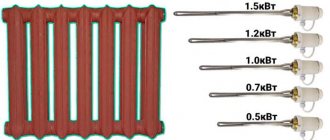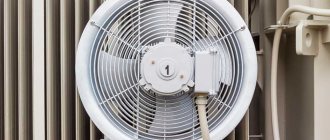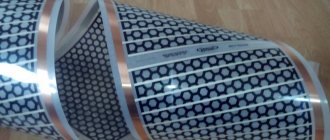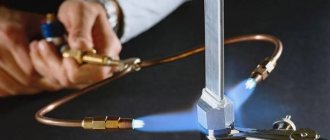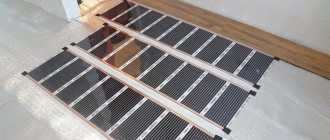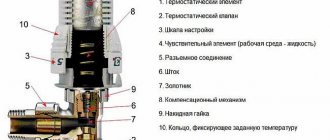With the onset of cold weather, the issue of home heating becomes more pressing. In the chilly off-season, centralized systems are often not turned on until the last minute, and then alternative heating systems come to the aid of freezing residents.
One of the simple solutions are considered to be heating elements for heating radiators, which can become an effective addition to the heating system. In some situations, the device can easily cope with the role of the main heat source, for example, in seasonal premises.
Before you decide to buy a device, you need to find out more information about it, don’t you agree? We have prepared a review article about the design of radiator heating elements, their classification, advantages and disadvantages. The material identifies the main criteria for choosing an electrical appliance and describes the features of its installation.
Distinctive features of heating elements for radiators
A heating element with a thermostat for a radiator is a design used as an alternative heat source, or as the main heating device.
It is a cylindrical part made of metal. It has a built-in wire that provides heating. Insulation occurs due to internal electrical coating.
The heating elements used for heating radiators contain a thermostat that is capable of heating the air to the desired level.
Installing the device will not require much time and effort. To do this you need:
- Install the device into the radiator.
- Connect the device to an outlet.
Due to the heating of the electrical appliance, heat will flow into the radiator.
When the device has reached the desired temperature, it will turn off automatically. When the temperature drops, it will automatically turn on. The device will fit almost any radiator.
General characteristics and operating principle
A radiator heating element is a device that can be used as an additional or main heating device. The device consists of a cylindrical metal body. A copper spiral or steel wire is mounted in the middle of it. Internal parts have an insulating coating.
The heating element intended for radiators is equipped with a thermostat. Thanks to this, the device can be used both for heating and for temperature control.
The operating principle of such electrical appliances is quite simple:
- a tubular electric heater is installed in the battery;
- the heating element is connected to the electrical network;
- The coils are heated, causing heat to flow to the coolant.
What does a heating element for a radiator look like?
Setting the required temperature is allowed if there is a regulator in the device. When the level of the specified mode is reached, the electrical circuit opens and the heating element turns off. When the temperature drops below the set upper limit, automatic heating occurs. You can connect the heating element to almost any battery.
Installation of heating elements
Heating elements can be used as an alternative system for heating water. In this case, it is necessary to take into account surges in the pressure of water that will pass through the heating systems.
Sometimes the device is connected to Soviet cast iron batteries. When installing a heating element for a cast iron radiator, you need to look at whether the outlet thread is directed to the left or right, and adjust its diameter to the appropriate parameters.
Then follow the instructions:
- Drain the water. Do not install in batteries filled with water.
- Check the battery level to avoid air build-up.
- Ensure tightness when installing the pipe. To do this, you need to use the gaskets that are included with the heating element.
- Install the device with a thermostat, if it is included in the assembly.
After installation, you can run water into the system. The valves on the radiators will ensure that there are no air pockets. Before starting the system, you need to check its security with a tester.
Efficiency mark
A heating element for a radiator is not a heating device that can be constantly used to heat a large area. One kilowatt of electrical appliance power is converted into one kilowatt of thermal energy, which is completely used to heat the room.
When using cast iron batteries, a heating element equipped with a thermostat with a heating power of 100 Watt/m² can heat no more than 25 m² of space. Electrical energy consumption for twenty-four hours will be 36 kW/h, which approximately corresponds to 167 rubles. This takes into account the average power consumption of 1.5 kW. If the heating system is well organized, installing a tubular type electric heater does not make sense.
A heating element for a radiator is most effectively used as an emergency device. If the heating system is unstable, such a device will allow you to maintain the required level of heat in the room even in severe frosts. Installing a tubular heater makes sense if its power is correctly selected and all safety rules are observed.
Electric space heating
There is no need to install a pipeline when creating a heating system using heating elements. For each battery, it is necessary to select devices of varying power, depending on the purpose of the room.
Advantages of electric heating:
- Minimum labor costs during installation.
- Automatic water and air heating system.
The disadvantage of radiator electric heating is the high consumption of electricity and the purchase of materials.
Safety issues and operating features
The tubular electric heater operates on mains power, which means it poses a certain danger if you do not follow a number of safety rules.
Recommendations for use and safety precautions:
- The radiator heating element will work for a long time and without breakdowns, in accordance with its technical parameters, if it is serviced every 3 months. The device is cleaned of scale that forms on its surface - this is necessary to ensure normal heat transfer. If the heater is not descaled in time, it may fail.
- Do not allow the electric heater to overheat. It is unacceptable to exceed the maximum temperature - +70 °C.
- The heating element can only be turned on in a radiator filled with coolant. If water gets on a hot appliance, a thermal explosion may occur. As a result, not only the battery will be damaged, but also the entire heating system.
- If static electricity appears on the surface of tubular heaters, immediately disconnect the device from the power supply and check all connections for leaks.
- The power of the heating element cannot exceed the thermal rated power of the radiator. There can be no more than 3.5 kW per outlet.
- If a heating element is installed in a radiator, it is necessary to provide reliable and proper grounding.
To reduce the intensity of scale formation on the radiator heating element, it is recommended to use distilled water as a coolant.
Types of heating elements
Tubular electrical appliances are divided into household (2.5-4 kW) and industrial (4-6 kW).
There are devices equipped with 2 spirals and other features:
- Antifreeze. The option prevents the system from freezing by constantly maintaining the temperature. This function does not require a lot of energy.
- Turbo heating. The option allows you to quickly heat the air using a thermostat.
Heating with heating elements, how to do it, is it worth using
A heating element is an electric liquid heater in the form of a metal tube, inside of which there is a spiral. There are many designs and varieties. Heaters are manufactured for both large and small industries.
These heaters are widely installed, for example, in electric boilers and electric boilers, and therefore are also produced by well-known manufacturers.
But in any market you can find heating elements intended for installation in heating radiators. These devices are often manufactured in Poland, Ukraine, and China. They can be equipped with built-in temperature sensors, i.e. work in semi-automatic mode, monitoring the degree of heating.
Based on such electric heaters, you can easily create a heating device with your own hands. This is what home craftsmen use, constructing the simplest heating and, as they think, “saving” a fair amount of money.
But is it really profitable to use heating elements? Where and in what situations are these electric water heaters usually used? How to install and use heating elements...
How big is the benefit from heating elements?
If you have an old battery, then why not use a heating element to turn it into a heating system for a small utility room - a chicken coop, a workshop, a garage...
There are even myths that heating with heaters is beneficial. But “dreams are shattered by harsh reality” - heating with electricity is the most expensive. Since the most expensive energy carrier is used.
It doesn’t matter whether there is a proprietary programmable electric boiler, or a barrel with a heating element lowered into it on a wire, the efficiency of such electric heaters is about 97%. And then we pay according to the meter...
Keep warm at night
But there is a loophole - a cheap nightly electricity tariff. You can find out exactly about the current tariffs and the possibility of connecting to the night power supply in the local power grid.
True, night electricity cannot be called cheap, but in combination with the “Comfort” indicator, night heating becomes very attractive to the user. What type of fuel is best for home use?
But the price of the electric heating system itself can vary significantly.
Heaters in batteries
When it is cold in apartments with central heating, they are heated additionally with electricity, as well as a gas stove or water heater.
This is where a couple of heavy cast iron batteries with heating elements are used. Compared to branded electric convectors, they have a much higher heat capacity, so you can turn them off for longer and not monitor their operation. But heating is correspondingly longer.
Craftsmen install such radiators mainly in garages, where they like to spend time. Or, for example, for heating animals in cold weather on small farms.
Heating system equipment
It happens that at the dacha, in the garage, etc. There are remains of the former heating system, for example, a couple of radiators with steel pipes. The easiest way to bring the system back to life is to insert electric heaters into it...
But heating elements can also create auxiliary heating in a home heating system. Electric heating perfectly complements a solid fuel boiler. Especially at night, with a cheap rate. And here “homemade production” is also in demand.
If you attach a pair of 2 kW heaters in a sufficiently large metal pipe, you will get a 4 kW electric boiler. The nuance is that at night it can be connected to a low-power 220 V network, since other consumers are “sleeping,” except for the refrigerator, for example.
Such a “creation”, in practice, can become the main heating during the season in an insulated house, if, of course, a buffer tank is used - a heat accumulator. How to connect a heat accumulator to the system
How much power will you need?
In a heating system for a whole house, it is better to use 2-kilowatt electric heaters.
But in individual radiators, homemade registers, heating scraps in garages... it is impossible to use heating elements that are too powerful.
The fact is that a thermal relay cannot be considered reliable protection. Bringing liquid to boiling point or overheating the device above +75 degrees is dangerous.
Therefore, the power of the heater should not be greater than the thermal power generated by the device at +70 degrees. This is approximately 75% of the radiator's rated power.
One section of both cast iron and aluminum radiators (500 mm between pipes) has a heat transfer power of 170 W at 90 degrees liquid and 20 degrees air. At +70 degrees. heating - one section - 140 W, 7 sections - 1080 W, 10 sections. — 1400 W. Thus, for a radiator of 7 sections, the power of the heating element should not be more than 1 kW. And for a radiator of 10 sections - no more than 1.4 kW.
The situation is more difficult with homemade registers - their heat transfer is unknown. All that remains is to start using the least powerful heaters.
Which radiator shades to choose
Heating elements for radiators are made on the basis of a plug (base) with a standard thread diameter of 40 mm. All that remains is to unscrew the bottom plug from the radiator and screw in the heater in its place.
The selection of these heaters by power for radiators was discussed above. You should not take more powerful devices to avoid emergency situations. There is no need to overheat the radiator, achieving greater heat transfer.
But these heaters also differ in length. For a free-standing radiator, without fluid movement, longer shades are preferable. Then the heating will be more uniform.
In a flow-through electric boiler, another selection priority is lower hydraulic resistance. Minimizing the influence of heaters by successfully connecting tubes and configuring their location is not a problem for the home craftsman.
, as before, they are criticized the most; the best heating elements are considered to be of local origin - Russian-Ukrainian ones.
How to use
Heating elements can be turned on by a room thermostat. Then they are controlled according to the set air temperature.
But in most cases, heaters with built-in temperature relays are used - heating according to the temperature of the coolant.
Liquid expands when heated. Individual radiators and other closed heating systems cannot be completely filled with liquid. In heating systems, an expansion tank is used to compensate for expansion. Expansion tanks for heating systems
In the case of a separate radiator, it is enough to leave at least 10% of the internal volume unfilled - fill the radiator up to the top plug.
The installation of the heating element is as follows. The system is drained, the radiator cap is unscrewed, and the heater is screwed in. In this case, flax with lubricant is usually used as a sealant (metal-to-metal).
The heater is connected to the electrical network in accordance with the PUE, with appropriate contact insulation.
Oil is not allowed
You may find recommendations to fill the radiator with oil, which supposedly turns out to be an analogue of an “oil heater.” Before following such advice, it is recommended to study the experience of a “pyrotechnician” who poured oil onto cardboard, set it on fire, and then tried to put it out. Oil-filled industrial electrical units (for example, high-voltage oil disconnectors) are operated with special fire safety measures.
If the system freezes, it is necessary to use non-freezing liquids; for one radiator you can use the same car antifreeze. Flammable liquids are not permitted.
There are also other violations.
Is designing with your own hands profitable?
Self-construction of electric heating devices is not encouraged for safety reasons.
It is much more expedient to purchase a ready-made electric space heater, for example, an electric convector that meets the requirements... The manufacturer is responsible for its performance.
Economic feasibility in heating elements can arise, as mentioned, when there is an “abandoned” and “free” shell for it.
But security issues are actually much more important than the benefits obtained in this way. Nowadays this is understood more often, which is why people are less and less interested in heating elements.
In addition, it is more profitable to heat a medium-sized house with an electric boiler with water radiators than with separate convectors. Further on the topic - is it profitable to heat with electric convectors?
Tubular Heater Options
Tubular heaters produce power from 0.3 to 6 kW. The thread can be directed either to the right or to the left. The diameter can have different values, most often 40 mm.
- There is no fundamental difference between electrical appliances, their mechanism is almost the same, the differences can only be in diameter. There are single and double devices.
- Double appliances are more efficient in operation. The advantages of this model are fast heating of the room, the disadvantages are high cost.
Double models are preferable to use. Two heating coils ensure quick heating of the device. After some time, one component automatically turns off, thereby saving energy.
Selection conditions
When purchasing a device, you need to consider its technical functionality, taking into account the size of the radiators.
It is necessary to pay attention to the following parameters, which are relevant for both cast iron batteries and heating elements for aluminum radiators.
- Power. It is necessary to select an electrical appliance depending on the thermal insulation characteristics of the building. For a house that retains heat well, an average power device of 2-3 kW is suitable. For older buildings, it is advisable to choose a more powerful device.
- Device length. It is advisable to buy devices 10 cm shorter than the radiator. When the length of the device is correctly calculated, the battery is heated evenly.
- Type of radiator. When selecting an electrical appliance, you must read its technical specifications. It says what types of radiators this model is used for.
Automatic control. It is advisable to purchase models equipped with automation.
How to choose?
Radiator heating elements are not so diverse as to create special difficulties when choosing. The main thing that people pay attention to when buying is power and design features.
Battery heating element for an aluminum radiator with a GREPAN temperature sensor and its characteristics.
Power calculation formula
To correctly calculate power, local standards of thermal performance indicators are needed (they are different for each region). But, in principle, you can also use the average indicator valid for central Russia.
Let the heater be the main heating in the house/room. For this case, you need a model with a thermostat. We take into account that for heating 10 sq. m is 1 kW. Devices used for emergency heating use 3-4 times less power.
The heat output of the radiator is specified by the manufacturer. At the same time, the average rating of one battery section made of cast iron is 140 W, and of aluminum - 180 W.
Heating without pipes, how to calculate the power of a heating element for a battery
Calculation formula for heating element power: Q = 0.0011*M (T1-T2)/t, where:
- M is the mass of the energy carrier;
- T1—temperature after heating;
- T2—temperature before heating;
- t is the time for maximum temperature increase.
Design Features
When choosing a heating element, its dimensions and thread direction are taken into account. The length of the rod, in particular, directly affects the efficiency. If the heating element is not long enough, the equipment will not be able to provide the required fluid speed. Because of this, the radiator will not heat up enough and unevenly.
The optimal length is considered to be at which the rod of the device does not reach the inner wall of the opposite side of the radiator by 6-10 cm. When choosing the shape and material of the plug, take into account the recommendations from the manufacturer - suitable options are usually indicated there.
Automatic control
When buying a radiator heating element, pay attention to whether it has automatic control . If yes, then you get the most convenient device that does not require the cost of purchasing additional accessories.
The self-controlled heating element is equipped with a thermostat built into the lower part of its body. It has a special sensor that measures the temperature of the liquid. Based on its readings, the heating element automatically turns on and off, saving energy.
In heating elements without automation there is no thermostat. Then it is recommended to connect it by installing a detector in the room to measure the air temperature in the room. This is an impractical and inconvenient option today; European manufacturers do not produce such devices.
Advantages and disadvantages of tubular electric heaters
Pros:
- Safety in operation.
- Easy to install.
- Long service life.
- Relatively low cost.
- Durability.
- Possibility to expand functionality.
Minuses:
- The movement of water in the radiator prevents electrical appliances from heating evenly.
- High energy costs.
Advantages and disadvantages
Tubular electric heaters contribute to uniform and complete heating of the heating system. Installing such devices has many advantages:
- safety of use;
- ease of installation;
- economical use;
- the ability to install additional options;
- reliability;
- long service life;
- relatively low price for the product.
Along with their advantages, heating elements for radiators have their disadvantages:
- When connecting a heating element, the high speed of liquid circulation in the radiator does not allow increasing the level of heat transfer. Thus, the operation of the heating system prevents uniform heating of the device.
- When using a heating element as the main heating device, the cost of electrical energy increases significantly.
Among the advantages of heating elements for radiators is their low cost.
The cost of the heating element itself is low, but when purchasing the necessary additional equipment to automate the work process, costs increase significantly. The complete set has a price several times higher than a convector operating on electricity.
Application area
As an independent source of heat, this device is used in the following cases:
- Heating radiators in places where there is no other type of heating. It is used in outbuildings, cottages or terraces. It is advisable to use oil in radiators to prevent the device from freezing.
- For occasional use. An ideal option for a country house or cottage.
As an additional device it can be used:
- In apartment buildings. Used when heating has low efficiency. The electrical appliance helps maintain the microclimate necessary for life.
- In residential buildings. It is used when it is not possible to install a boiler, or it is not possible to use firewood on an ongoing basis.
Installation
You can install the heating element yourself. Progress:
- Remove the plug from the radiator.
- Mount the device using threads and gaskets.
It is necessary to take into account that the mounts included with the device are fragile. Installation of the device must be done carefully, without using force.
During installation, it is necessary to take into account that due to the heating element, the pressure in the radiator increases. It is advisable to install a valve on the battery to adjust the pressure in the system.
For the best effect, it is advisable to install the device at the bottom of the radiator.
